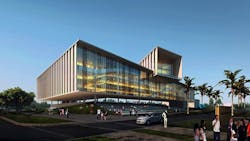$150 million building at Florida International University will boost STEM efforts
Florida International University has announced plans to build a $150 million, 225,000 square-foot engineering building just south of its main campus in Miami.
The project is part of the university's effort to intensify its commitment to science, technology, engineering and mathematics (STEM) education.
The new building will help FIU pursue its goal of boosting the number of engineering students it graduates by 20 percent by 2020. Expanding the engineering program is projected to result in an additional 350 engineers graduating annually and the creation of 550 jobs in South Florida.
“This engineering expansion will propel South Florida forward by expanding the quantity and quality of jobs, nurturing start-up companies and acting as a collaborative research center,” says University President Mark B. Rosenberg.
The facility is to be built on land now used by the Miami-Dade County Fair and Exposition. The building will be designed using environmentally friendly strategies and materials to achieve LEED Gold certification.
The added space will enable the College of Engineering and Computing would grow from 2,061 students to 7,500, and increase faculty from 105 to 214. Research expenditures will increase by $30 million annually. FIU says much of the growth in engineering will take place in disciplines closely aligned with medicine, nursing, health sciences and public health.
The building’s proximity to other academic programs will encourage collaboration in areas such as biomedical engineering, cybersecurity, electrical engineering, nanotechnology drug delivery and environmental engineering.
About the Author
Mike Kennedy
Senior Editor
Mike Kennedy, senior editor, has written for AS&U on a wide range of educational issues since 1999.
